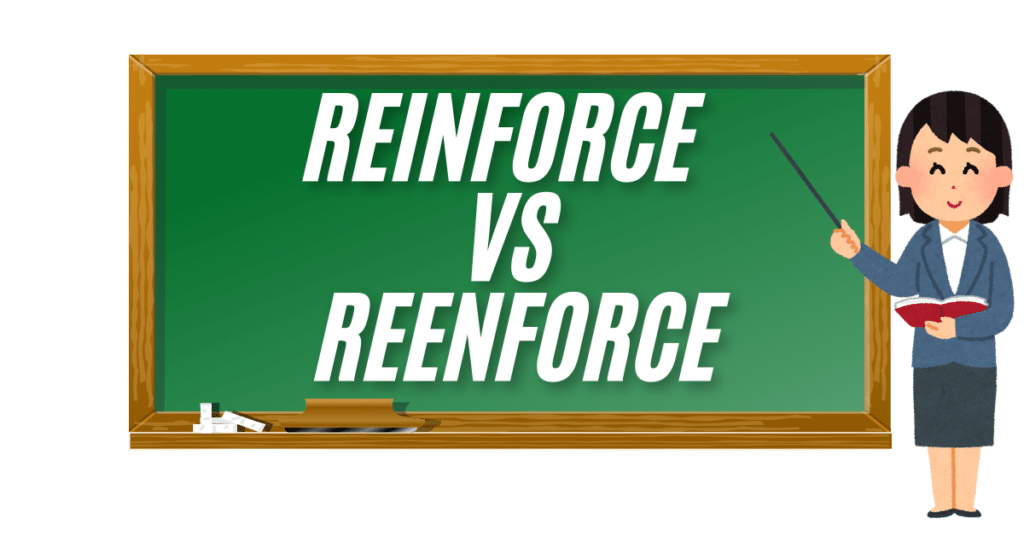The debate between reenforce vs reinforce often causes confusion, but understanding the difference is key. Reinforce is the correct spelling, commonly used to mean strengthening or supporting something, whether it’s an idea, structure, or behavior. On the other hand, reenforce is an incorrect or rarely used variant.
While some may mistakenly write it, reinforce is the term that is accepted in professional and academic contexts. Knowing the correct spelling is essential, especially when writing in formal settings, as reinforce is the only proper version that carries clear, established meaning in English.
What’s the Difference Between Reinforce and Reenforce?
The confusion between “reinforce” and “reenforce” is common, but understanding the difference is essential to mastering English spelling and usage. So, what’s the real distinction? Well, it’s pretty simple once you know the facts:
Reinforce is the correct word, while reenforce is generally considered a misspelling. But let’s dive deeper into why this happens and why it matters in both everyday language and professional writing.
Is Reenforce a Misspelling of Reinforce?
Yes, reenforce is commonly seen as a misspelling of reinforce. The confusion often arises because the word reenforce looks similar and might make sense to some speakers or writers. However, the proper spelling is reinforce, which has been recognized as the correct form for centuries. Using reenforce instead of reinforce can lead to errors in both written and spoken language.
Read more about Emersion vs. Immersion: Understanding the Differences
Why Reinforce is the Preferred Spelling
The preference for reinforce over reenforce stems from its established history in the English language. The word has its roots in the Latin reinforcare, meaning “to strengthen.” Over time, reinforce became the standard spelling, while reenforce has fallen out of use. Correct spelling is essential, particularly when trying to communicate clearly and professionally.
Common Confusion: Reinforce vs Reenforce
The key to distinguishing between reinforce and reenforce lies in understanding their usage and historical development. While reinforce is the accurate form, many mistakenly add an extra “e,” thinking it is a valid variation. This is a common issue, especially in informal settings. Ensuring you’re using reinforce correctly can help maintain the clarity and professionalism of your writing.
Understanding the Definitions of Reinforce and Reenforce
Before we explore the nuances of spelling, it’s important to understand what each word means and how they are used in context.
What Does “Reinforce” Mean?
Reinforce means to strengthen or support something further. For example, you might reinforce an argument with more evidence, or you might reinforce a building to ensure its safety. It’s a term commonly used in various fields, from education to construction, to describe strengthening actions.
Does “Reenforce” Have a Definition?
Technically, reenforce doesn’t have a recognized, separate definition in modern English. It’s often just seen as an incorrect variation of reinforce. In most dictionaries, you will find that reenforce is either absent or labeled as a misspelling of reinforce.
The Correct Spelling: Reinforce vs Reenforce
Spelling errors are common in English, and the reinforce vs reenforce confusion is just one example. Let’s break down why “reenforce” doesn’t hold up.
Why “Reenforce” is Not Commonly Used
Reenforce is rarely used in formal or academic settings because it doesn’t align with the standard rules of English spelling. The correct form, reinforce, is deeply embedded in the language, and continuing to use the wrong version can make your writing appear less credible or professional.
Spelling Rules and Common Mistakes
One common mistake when writing reinforce is adding an extra “e,” leading to reenforce. This is often an accidental typo, but it can impact the quality of your writing. When unsure about the spelling, it’s best to stick with reinforce, the word that follows all standard spelling rules in English.
Etymology and History of Reinforce and Reenforce
Exploring the origins of reinforce and reenforce can shed light on why one is correct and the other isn’t.
The Latin Roots of “Reinforce”
Reinforce comes from the Latin reinforcare, meaning to strengthen. This word evolved into the modern English reinforce, which has retained its meaning over time, signaling strength, support, or bolstering something already in place.
Does “Reenforce” Have Historical Significance?
Reenforce has no historical significance as a separate term. It seems to have emerged as an erroneous variation of reinforce and has never held a defined place in the historical development of the English language.
Usage of Reinforce and Reenforce in Modern English
The most important thing to understand is how both words are used today. While reinforce is common and widely accepted, reenforce is largely absent from formal English.
How “Reinforce” is Used in Everyday Language
Reinforce is a versatile word used to describe actions that strengthen or enhance something. Whether it’s reinforcing a team’s motivation or reinforcing a physical structure, the term is essential in many fields, including education, psychology, and engineering.
Why “Reenforce” is Rarely Seen in Professional Writing
Since reenforce is considered a misspelling, it is rarely found in professional writing or academic papers. Writers who aim for accuracy and clarity always opt for the correct spelling reinforce.
Verb and Noun Forms of Reinforce
Understanding how reinforce works in different grammatical forms is crucial for proper use.
How to Use “Reinforce” in Verb Forms
Reinforce is primarily used as a verb, meaning to strengthen or enhance something. For example, you might say, “We need to reinforce our understanding of this topic.”
What is the Noun Form of Reinforce?
Read more about Opened vs Openned: Correct Spelling & Usage Examples
The noun form of reinforce is reinforcement. It refers to the act or process of strengthening something, such as “The reinforcement of the building was crucial for its stability.”
Can “Reenforce” Be Used in These Forms?
No, reenforce doesn’t have accepted verb or noun forms. The correct forms are only associated with reinforce, which can be used flexibly across different grammatical contexts.
Examples of Reinforce in Sentences
Let’s explore some practical examples of how reinforce is used in real-world contexts.
Educational Context: How Teachers Reinforce Learning
In classrooms, teachers often reinforce key concepts through repetition, quizzes, or visual aids to ensure students understand the material.
Construction and Engineering: Reinforcing Structures
Engineers reinforce buildings with steel beams or concrete to ensure they can withstand extreme conditions, such as earthquakes or strong winds.
Psychological Reinforcement: Using Rewards for Positive Behavior
In psychology, reinforcement is used to encourage positive behavior. For instance, rewarding a child with praise can reinforce good habits.
Reinforcing Communication: Why Visuals Are Important
Using visuals to reinforce your message is crucial in both presentations and teaching. It helps make complex ideas clearer and more engaging.
Synonyms for Reinforce: What Other Words Can Be Used?
Read more about Perform or Preform: What’s the Difference?
If you’re looking to diversify your vocabulary, there are several synonyms for reinforce that might be appropriate in different contexts.
Alternatives Like “Strengthen” and “Support”
Words like strengthen or support can often be used in place of reinforce. For example, “We need to strengthen the team” is an alternative to saying, “We need to reinforce the team.”
When to Use “Bolster” and “Fortify”
In certain contexts, bolster and fortify are more precise alternatives. For example, “She bolstered her argument with strong evidence” or “They fortify their defenses to prepare for a siege.”
Reinforce vs Reenforce Grammar
Understanding the proper grammar and usage of reinforce versus reenforce can improve your writing.
Common Grammar Mistakes to Avoid
Avoid adding an unnecessary “e” to reinforce. It’s easy to do, but it’s a mistake that can undermine the accuracy of your writing.
Proper Sentence Structure with Reinforce
When using reinforce, ensure that the sentence structure is clear. For example, “The manager reinforced the team’s commitment by setting clear goals.”
What Does Reinforce Mean in Education and Psychology?
In both education and psychology, reinforce is a critical concept.
Using Reinforcement in the Classroom
Teachers use reinforcement techniques to encourage learning, such as rewarding students for completing assignments or showing improvement.
Positive vs Negative Reinforcement in Behaviorism
In behaviorism, reinforcement can be positive (rewarding good behavior) or negative (removing an unpleasant stimulus to encourage a behavior).
How to Spell “Reenforce” Correctly
Let’s address some common mistakes when it comes to spelling reenforce.
Common Errors with “Reenforce”
The most common error with reenforce is the extra “e” that’s mistakenly added. If you stick with reinforce, you’ll always be correct.
Why “Reinforce” is the Only Correct Spelling
Reinforce is the only correct spelling according to English dictionaries. Always double-check your spelling to ensure clarity.
Read more about Fairing or Faring? Understanding the Difference
The Adjective Form of Reinforce
There is an adjective form of reinforce, and it’s reinforced.
What Does “Reinforced” Mean?
Reinforced refers to something that has been strengthened or made more durable, such as reinforced concrete or a reinforced learning strategy.
Using Reinforced in Context
You might say, “The building was reinforced with additional support beams,” to describe an improvement in the structure’s stability.
The Role of Reinforce in Performance Management
In the workplace, reinforce plays an essential role in motivating employees and improving performance.
How Reinforcement Improves Team Performance
Reinforcing positive behavior and accomplishments within a team can boost morale and increase productivity.
###
Strategies for Reinforcing Employee Motivation
Regular feedback, rewards, and recognition can help reinforce employees’ motivation and lead to higher job satisfaction.
Regional Differences of Reinforce and Reenforce
Interestingly, reinforce is the standard in most English-speaking countries, though some regional variations may exist in casual speech.
Which One Is Right – Reinforce or Reenforce? What’s the Main Answer?
The main answer is simple: Reinforce is the correct spelling. Stick with this version to avoid confusion and errors.
What Word Can I Use Instead of Reinforce?
If you’re looking for alternatives, you can use words like strengthen, bolster, or fortify depending on the context.
conclusion
The correct term is reinforce, and reenforce is a misspelling. Understanding the difference between the two can enhance your writing, making it more accurate and professional. Reinforce is widely accepted in both everyday and academic language, and it refers to the idea of strengthening or supporting something. The confusion arises due to similar pronunciation, but knowing when and how to use reinforce ensures clarity and correctness in communication, whether you are writing a paper, email, or any other formal text.

Luna Jasper is an experienced blogger with a passion for language and grammar. At **Collective Nouns World**, she shares her expertise in exploring the fascinating world of collective nouns, making learning both engaging and fun. With years of writing and research under her belt, Luna’s insightful articles help readers understand and appreciate the English language.







